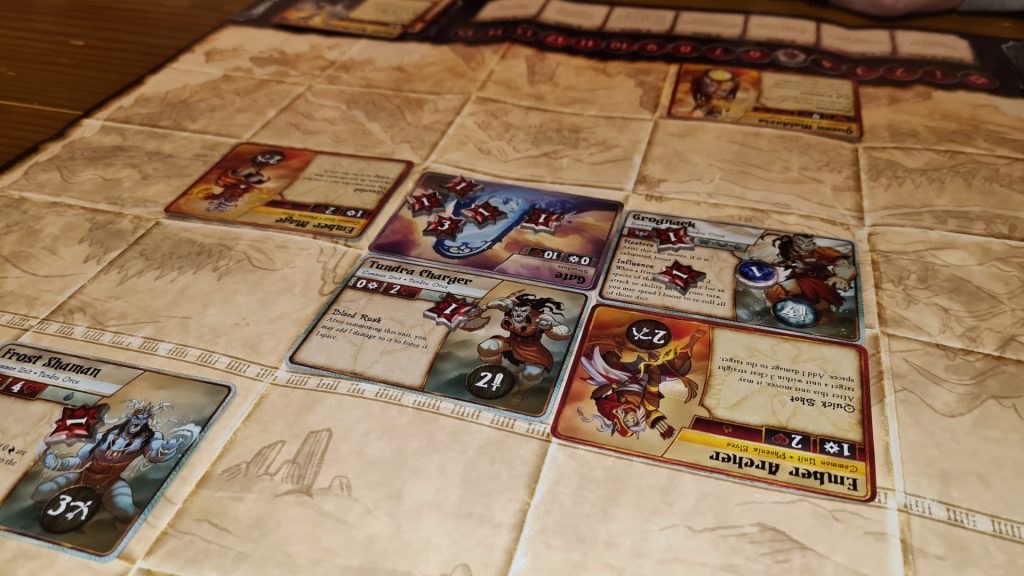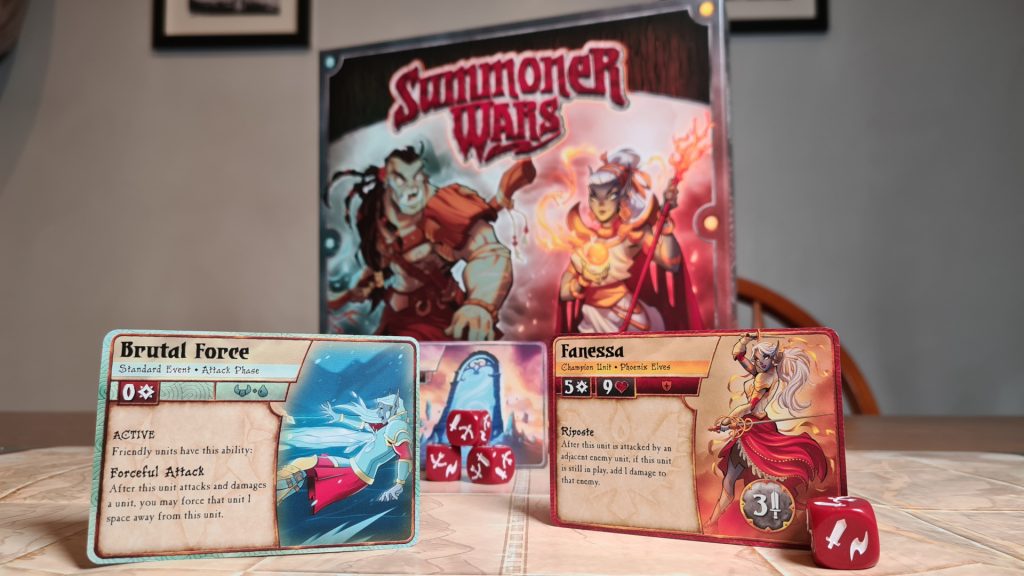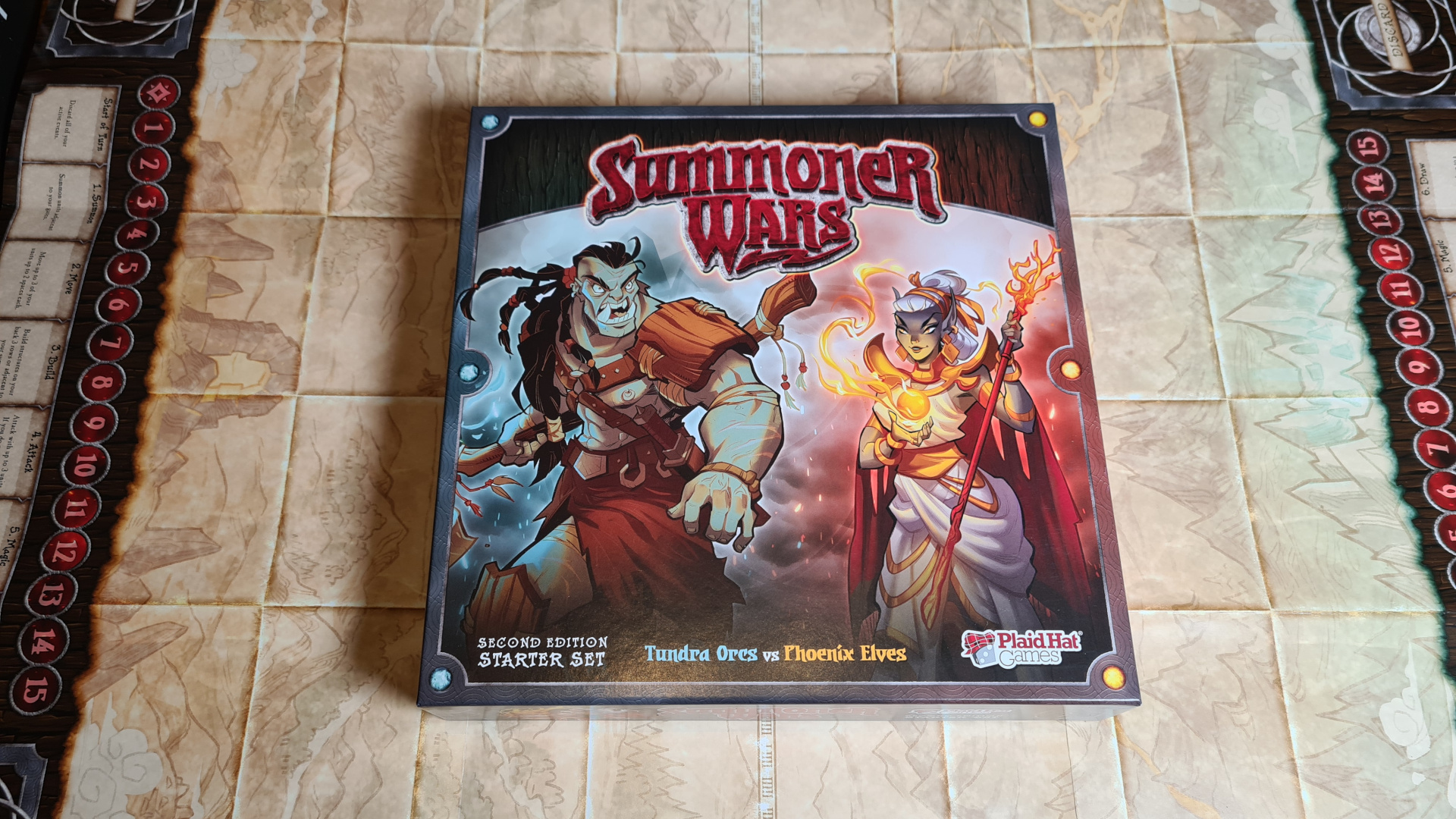Summoner Wars Second Edition Starter Set is the brand new release from Plaid Hat Games. This 2 player only fantasy fighting game is designed by Colby Dauch, features artwork from Martin Abel and Madison D. Johnson, and sees gamers play out battles of Phoenix Elves vs. Tundra Orcs. These two factions are not included in the Master Set, which was released a few months ago, with this being a standalone game – which can also expand the content of the Master Set. However, is Summoner Wars Second Edition going to have to battle to get to your gaming table? Let’s find out!
For this starter set each player takes one of the two decks, taking control of either the Phoenix Elves or the Tundra Orcs. Note, in the first printing two mercenary cards are included that can be left in the box. Each Summoner card shows the player which units they start with and their placement, alongside that of their starting 10 hit point gate and Summoner. Following this setup both players will have 2 common units, 1 gate and their Summoner on the battlefield. Determining who will start they set their magic value to 2 on the tracker on their side of the board. Their opponent then sets the tracker to 3 on their side. Before play begins each player shuffles the rest of their deck to make their draw pile and draws a starting hand of 5 cards.
On a turn the active player follows 7 steps; start, summon, move, build, attack, magic and draw. It sounds a lot but they are short quick phases. At the start of your turn any active events are discarded, often being buffs from your last turn. By spending magic the player can then summon in units. Each unit, common or otherwise, has a magic cost (though it can be zero). Unless otherwise stated by an ability, units are spawned in adjacent to your gates – with diagonals not included. If those spaces are blocked then units cannot be summoned.
Next the player can move up to 3 units up to 2 spaces. Movement must be to adjacent spaces and cannot be through occupied spaces. After moving the player can build structures – which are often additional gates that come out of the player’s deck. These give additional spawning spaces for summoning units and, as gates can be destroyed, may need to be built by a player to summon at all.

Then it is time to attack! Players must attack at least once on their turn, else their Summoner takes an inactivity damage penalty. Choosing up to three units, which can be different from the three that moved, they each attack. Units are either melee or ranged, denoted by a sword or bow symbol, alongside a strength value. Melee attacks can only be used on adjacent units/structures, while ranged attacks can be up to 3 spaces away in a clear straight line in up, down, left or right directions.
With the target chosen the player rolls as many dice as the attacking unit has strength. When rolling for melee players are looking for sword symbols. For ranged attacks they are looking for bow symbols. The dice also feature a special lightning symbol which for the most part is ignored. For each of the correct symbol rolled damage is dealt to the targeted unit or structure. Damage is added to cards via tokens, and when the number of tokens matches that unit’s health it is removed from play. Whenever you remove an opponent’s card from play you gain 1 magic.
After the attacks, the player then has the option to discard any cards from their hand, gaining 1 magic for each. Aside from defeating cards this is the only way to gain magic, though is burning through your deck – which never gets reshuffled. Finally, the active player draws up to a hand of 5 cards, not drawing if they are at or above 5 cards, nor if their draw pile is empty. Play then moves to the opponent, to follow the same phases. The game continues until one of the summoners is defeated. It matters not how many of the units or gates you destroy, the only way to win is to defeat the opposing summoner.
A great strength of Summoner Wars is that the game has simple rules and simple phases to follow. Players work their way through the 6 (excluding start) steps and are even reminded of them and their order at the bottom of the main board. The limitations, such as move up to 3 units, are clearly listed too. Players are therefore left with the abilities and the decisions to make. There are a lot of abilities, though each deck features repeating common units – so not every card out of the deck requires to be extensively read. This also ebbs away quickly and after a game or two players need only glance at the card coming out of the deck to know what it does.
The game length is never stretched too much as there is an endpoint. At some point you’ll run out of cards, not be able to attack, lose summoner health each round, and eventually you’ll be out. This is a slightly anticlimactic way to win or lose, though players would have to be significantly burning through their decks for this to regularly occur. Also at this stage the opponent has free reign to blow your summoner up, so the game won’t last much longer.

Different tactics or strategies work depending on who you’re facing. A prime example of this is how against the Phoenix Elves a plan to smash your opponents gates and leave them unable to summon new units won’t work. Not only do they have gates in their deck, as both included factions do, one of their champions can have “ember” units summoned adjacent to. Reversing this strategy, being used by the Phoenix Elves against the Tundra Orcs, could 100% work to completely disrupt your opponent and slowly leave their summoner unprotected!
The Summoner Wars Second Edition Starter Set attempts to walk the fine line between offering a cheaper entry point into the series with what content is included. It is a great way for people to try the game without committing to the main set, and allows more gamers to experience Summoner Wars – who may not have otherwise been able to afford to. There have been trade-offs though and also some oddities that just make it feel cheaper.
Clearly the decision was made to reduce the cost by including a paper “board” rather than a cardboard one – which is found in the Summoner Wars Second Edition Master Set. It is made out of thick, glossy, poster-like paper but still really drags down the overall production quality. It’ll show wear and tear quicker due to being folded and unfolded and isn’t as premium. Another decision which makes the set feel lesser is that the rulebook features an example using a faction not in this starter set. It wouldn’t have been hard for Plaid Hat to re-do the example with cards included in either starter set deck, and it’s always better when you can flick through and find the cards used in an example to lock in your understanding.
Summoner Wars Second Edition is a 2 player title that is quick to understand but offers plenty of room for experience to shine. One strategy will work one direction but not the other, which cards to discard and when for magic, where to move for that slight advantage – plenty goes through players heads. This Starter Set is more than just a taste of the action, it’s a full game. The two decks play differently. Plus, there’s a real tactical back and forth to the playing of cards and balancing magic. It’s a fine balance between this being a cheap entry point with missing out on content, and whilst it has some problems in this area, the Summoner Wars Second Edition Starter Set is a great cheaper way to try out this tactical game – which you can expand later on down the line.
(Editor’s Note: Summoner Wars Second Edition Starter Set was provided to us by Asmodee for the review. The game is currently available from local board game stores! Find your local store here.)

